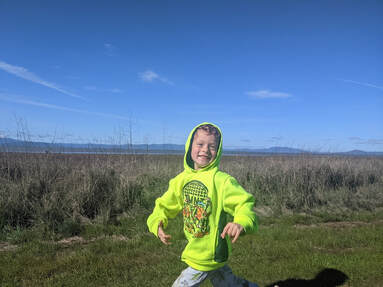 Our many friends used to channel and role play our emotions at home. Our many friends used to channel and role play our emotions at home. The topic of emotional intelligence has come up frequently as I live and grow with a three-year-old. From managing tantrums (both his and mine), finding words to express our feelings, to navigating a bully at childcare, social-emotional skills are paramount as they help us identify and manage our emotions, express empathy, form meaningful relationships, and cope with stress. What I have learned is that emotional intelligence is a fundamental skill that starts in early childhood, develops and evolves over our lifetime, and is predictive of adult outcomes ranging from physical health, crime, and substance abuse by the time our kids are in kindergarten. Emotional intelligence is shaped by the experiences children have with those who care for them. A caregiver’s ability to respond to their needs, share love, acceptance, and warmth sends our kids a message about their own self-worth and ability to trust others. It also fosters resilience and gives them the confidence to persevere when they face challenges. As I grapple with the recent wave of mass shootings* and reflect on the startling increases in anxiety, depression and suicide in youth and adults, it is evident that fostering emotional intelligence in childhood is essential. Here are some ways we can help our kids (and each other) become more emotionally intelligent: 1. Get comfortable talking about feelings. As I shared in a recent post, research finds that just naming our emotions can have a calming effect. Noticing and naming our emotions diminishes their intensity and gives us the chance to take a step back and make choices about what to do with them. It also helps builds a child’s emotional vocabulary, which enables them to perceive their own feelings and those of others. There are everyday opportunities to talk to kids about emotions, but it all starts with us as caregivers. It isn’t always easy and the tendency to invalidate and suppress them is prevalent in our culture. Ask yourself, how did your parents (or caregivers) respond when you were upset? Did you feel like you could talk to them when you were angry, or you felt misunderstood? The chances are, if we struggle to talk about our feelings as adults it’s likely because we were never provided the space to do so as children. At our home, we use a feelings chart to acknowledge and name our emotions. When I find myself frustrated at my son, I try to articulate what I am feeling and why, which in practice helps me calm down while role modeling healthy emotional regulation. We also use stuffed animals and toys to work through our emotions. When reading to our kids, we can also talk about how characters feel and what happened to cause their feelings. 2. Listen empathetically and acknowledge feelings When a child is upset it can be tempting to be dismissive, telling them that it will be alright. In reality, this is sending them a message that that the way they're feeling is wrong. A better approach is to acknowledge their feelings and show empathy—even if we don’t understand why they're so upset. Children (and us adults) need to feel understood. Take a deep breath, relax, and focus on them. They’ll notice if you’re impatient or frustrated and just going through the motions. Try sharing simple observations. Say, “I noticed that you frowned when I mentioned going to the party” and then wait for a response. Or “You look so sad. Let’s see if we can make you feel better.” We can also make an effort to help kids challenge or reframe unhelpful negative self-talk as it appears. When a child says, "he/she doesn't want to be my friend" or “I can’t do math”, we can acknowledge the feeling (not the words), help them reframe it with more positive self-talk, and shift them into a growth mindset. 3. Teach and role model healthy coping skills We’ve all experienced it. Those days where we are hungry or under slept we may act more impulsively or have a shorter fuse. When we are at our best, it’s easier to stay in control of our emotions. Good self-care and predictable routines help children feel secure and can boost resilience. All of us need regular meals and adequate sleep. In addition, we can all benefit from learning how to take a few deep breaths when we’re angry or anxious. Role modeling these important behaviors sets an example for our kids and will support healthy habits that they’ll carry throughout their lives. When experiencing tough emotions, we can ask them open ended questions or get clarity by using either or questions: "Did you feel more upset about THIS or THIS?" "Were you more angry OR worried?" We can encourage our kids to draw their feelings or write about them in a journal. Maybe they just need some fresh air! Time spent in nature has been shown to ease symptoms of stress and anxiety and help us feel happier and healthier. We also know that exercise boosts mood and is a good outlet for strong feelings; inspiring a love of movement is the greatest gift we can give our kids. 4. Practice problem-solving Part of building emotional intelligence involves learning how to solve problems. When problems arise, we can’t always rush in to solve them for our kids. If your kid gets in trouble at school, breaks something, ore hurt themselves or someone else we can ask them “What can we do to make sure this doesn't happen again?". Of course, kids need consequences, but for real independence and self-efficacy to flourish we need to encourage them to make good decisions. And it's essential since research reveals that that kids who lack problem-solving skills are at higher risk of depression and suicidality. Cultivating good emotional health paves a path for long-term health and well-being. It starts at home. And we should demand that our schools and caregivers investing in more social and emotional learning to help prepare our kids to live not just a thriving life, but also a non-violent life. *One final note about mass shooters. A database of every mass shooter dating back to 1966 found that that the majority experienced early childhood trauma and exposure to violence at a young age. Preventing childhood trauma may seem daunting, but we know from the research on Adverse Childhood Experiences (ACEs) that the presence of a reliable, sensitive, and nurturing adult is one of the strongest protective factor against childhood trauma. Just one caring adult can have a huge positive impact on a child’s well-being. In addition, practically every mass shooter had reached an identifiable crisis point in the weeks or months leading up to the shooting. As a society, we need to be more proactive. Most mass public shooters are suicidal, and their crises are often well known to others before the shooting occurs. Schools and workplaces should teach resilience and social emotional learning and implement policies and practices that decrease the stigma around mental illness. This could not only help prevent mass shootings, but will also help promote the social and emotional success of all Americans, which is suffering. ********* I am proud to work for an organization committed to supporting the health of its community. In my current role, I help businesses build a culture of health at work and promote resilience, trauma-informed care, and social and emotional learning in the school environment. My wish is for more workplaces, employees, schools, and teachers to advantage of our amazing resources. Please help spread the word! Thrive at Work - Thriving Schools – Ready, Set, Rise! - Alliance for a Healthier Generation - More tips for early childhood teachers and providers here.
0 Comments
We all know the benefits of exercise. It helps controls weight, combats chronic disease, improves mood, strengthens our immune system, boosts brainpower, and promotes better sleep. It can also be fun and feels great! And when we exercise in nature it can evoke awe.
We also know we’re not getting enough of it. Even before the pandemic only 23% of Americans met Physical Activity Guidelines for both* aerobic and muscle-strengthening activity with 53% meeting the guidelines for aerobic activity. Let's pause a moment and take in the good. Close your eyes and think about the last time you got a little dose of movement and felt better. Hold on to that feeling and let that be your motivation to get you out the door. Even if it’s just a quick walk around your block to start. The beauty of exercise is that it’s for everyone. No matter your age, health, or physical abilities, there are so many ways we can stay active and find joy in the process. If your shoes have gathered dust during this pandemic, it’s all good. Especially during these times we need to be kind to ourselves and practice self-compassion. Start today. Hit up the trails, pump up your bike tires, tune into that yoga video. You’ll feel so much better I promise you. *In addition to getting at least 30 minutes of moderate-intensity exercise most days of the week we should also do resistance training to build up muscle strength twice a week. But some exercise, even if it is pretty minimal, is better than none. |
AuthorHello and welcome! My name is Andrea Notch Mayzeles. I am a Certified Health Education Specialist, Mom, and Master of Public Health dedicated to the path of well-being. As a wellness professional I am committed to continued learning and am here to share research, recipes and musings on health, psychology, personal development, and parenting. I hope you enjoy! Categories
All
|



 RSS Feed
RSS Feed